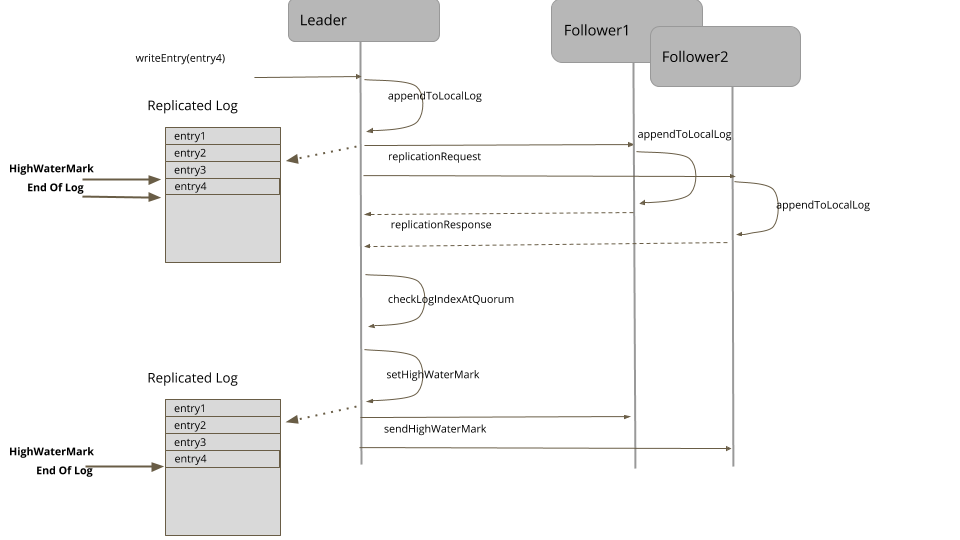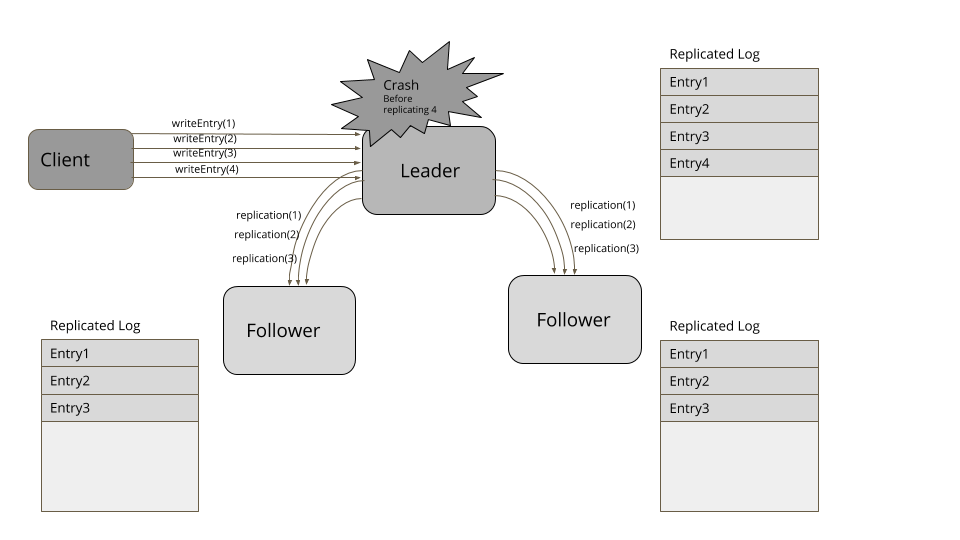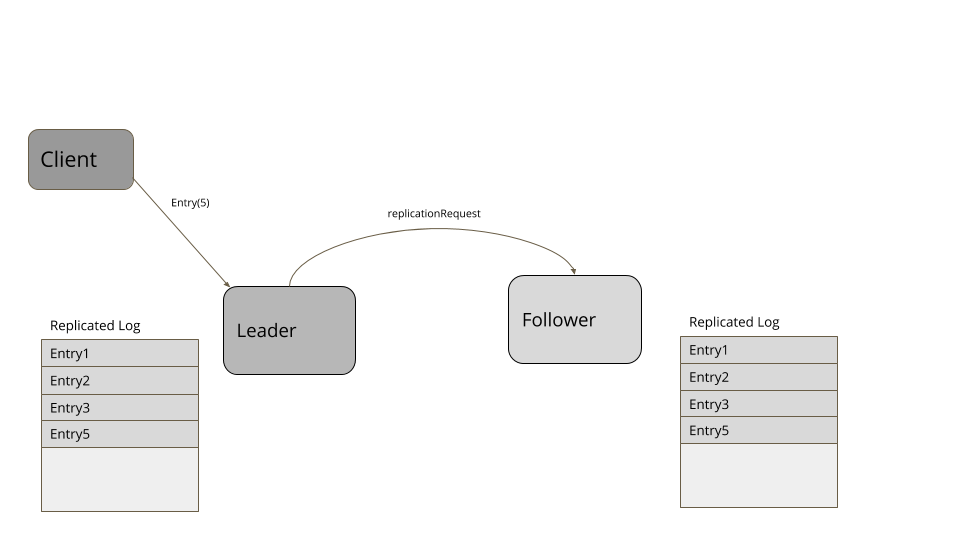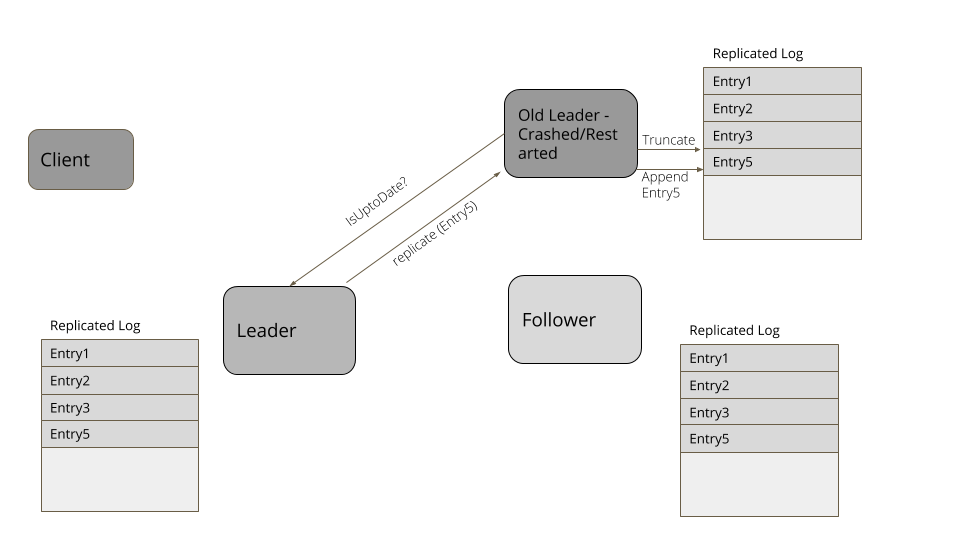高水位标记(High-Water Mark)
原文
https://martinfowler.com/articles/patterns-of-distributed-systems/high-watermark.html
预写日志中的索引,表示最后一次成功的复制。
2020.8.5
又称:提交索引
问题
预写日志(Write-Ahead Log)模式用于在服务器奔溃重启之后恢复状态。但在服务器失效的情况下,想要保障可用性,仅有预写日志是不够的。如果单个服务器失效了,只有等到服务器重启之后,客户端才能够继续使用其功能。为了得到一个更可用的系统,我们需要将日志复制到多台服务器上。使用领导者和追随者(Leader and Followers)时,领导者会将所有的日志条目都复制到追随者的 Quorum 上。如果领导者失效了,集群会选出一个新的领导者,客户端在大部分情况下还是能像从前一样继续在集群中工作。但是,还有几件事可能会有问题:
- 在向任意的追随者发送日志条目之前,领导者失效了。
- 给一部分追随者发送日志条目之后,领导者失效了,日志条目没有发送给大部分的追随者。
在这些错误的场景下,一部分追随者的日志中可能会缺失一些条目,一部分追随者则拥有比其它部分多的日志条目。因此,对于每个追随者来说,有一点变得很重要,了解日志中哪个部分是安全的,对客户端是可用的。
解决方案
高水位标记就是一个日志文件中的索引,记录了在追随者的 Quorum 中都成功复制的最后一个日志条目。在复制期间,领导者也会把高水位标记传给追随者。对于集群中的所有服务器而言,只有反映的更新小于高水位标记的数据才能传输给客户端。
下面是这个操作的序列图。

对于每个日志条目而言,领导者将其追加到本地的预写日志中,然后,发送给所有的追随者。
leader (class ReplicationModule...)
private Long appendAndReplicate(byte[] data) {
Long lastLogEntryIndex = appendToLocalLog(data);
logger.info("Replicating log entries till index " + lastLogEntryIndex + " on followers");
replicateOnFollowers(lastLogEntryIndex);
return lastLogEntryIndex;
}
private void replicateOnFollowers(Long entryAtIndex) {
for (final FollowerHandler follower : followers) {
replicateOn(follower, entryAtIndex); //send replication requests to followers
}
}追随者会处理复制请求,将日志条目追加到本地日志中。在成功地追加日志条目之后,它们会把最新的日志条目索引回给领导者。应答中还包括服务器当前的时代时钟(Generation Clock)。
follower (class ReplicationModule...)
private ReplicationResponse handleReplicationRequest(ReplicationRequest replicationRequest) {
List<WALEntry> entries = replicationRequest.getEntries();
for (WALEntry entry : entries) {
logger.info("Appending log entry " + entry.getEntryId() + " in " + serverId());
if (wal.exists(entry)) {
logger.info("Entry " + wal.readAt(entry.getEntryId()) + " already exists on " + config.getServerId());
continue;
}
wal.writeEntry(entry);
}
return new ReplicationResponse(SUCCEEDED, serverId(), replicationState.getGeneration(), wal.getLastLogEntryId());
}领导者在收到应答时,会追踪每台服务器上已复制日志的索引。
class ReplicationModule…
recordReplicationConfirmedFor(response.getServerId(), response.getReplicatedLogIndex());
long logIndexAtQuorum = computeHighwaterMark(logIndexesAtAllServers(), config.numberOfServers());
logger.info("logIndexAtQuorum in " + config.getServerId() + " is " + logIndexAtQuorum + " highWaterMark is " + replicationState.getHighWaterMark());
var currentHighWaterMark = replicationState.getHighWaterMark();
if (logIndexAtQuorum > currentHighWaterMark) {
applyLogAt(currentHighWaterMark, logIndexAtQuorum);
logger.info("Setting highwatermark in " + config.getServerId() + " to " + logIndexAtQuorum);
replicationState.setHighWaterMark(logIndexAtQuorum);
} else {
logger.info("HighWaterMark in " + config.getServerId() + " is " + replicationState.getHighWaterMark() + " >= " + logIndexAtQuorum);
}通过查看所有追随者的日志索引和领导者自身的日志,高水位标记是可以计算出来的,选取大多数服务器中可用的索引即可。
class ReplicationModule…
Long computeHighwaterMark(List<Long> serverLogIndexes, int noOfServers) {
serverLogIndexes.sort(Long::compareTo);
return serverLogIndexes.get(noOfServers / 2);
}领导者会将高水位标记传播给追随者,可能是当做常规心跳的一部分,也可能一个单独的请求。追随者随后据此设置自己的高水位标记。
客户端只能读取到高水位标记前的日志条目。超出高水位标记的对客户端是不可见的。因为这些条目是否复制还未确认,如果领导者失效了,其它服务器成了领导者,这些条目就是不可用的。
class ReplicationModule…
public WALEntry readEntry(long index) {
if (index > replicationState.getHighWaterMark()) {
throw new IllegalArgumentException("Log entry not available");
}
return wal.readAt(index);
}日志截断
一台服务器在崩溃/重启之后,重新加入集群,日志中总有可能出现一些冲突的条目。因此,每当有一台服务器加入集群时,它都会检查集群的领导者,了解日志中哪些条目可能是冲突的。然后,它会做一次日志截断,以便与领导者的条目相匹配,然后用随后的条目更新日志,以确保它的日志与集群的节点相匹配。
考虑下面这个例子。客户端发送请求在日志中添加四个条目。领导者成功地复制了三个条目,但在日志中添加了第四项后,失败了。一个新的追随者被选为新的领导者,从客户端接收了更多的项。当失效的领导者再次加入集群时,它的第四项就冲突了。因此,它要把自己的日志截断至第三项,然后,添加第五项,以便于集群的其它节点相匹配。



暂停之后,重新启动或是重新加入集群,服务器都会先去寻找新的领导者。然后,它会显式地查询当前的高水位标记,将日志截断至高水位标记,然后,从领导者那里获取超过高水位标记的所有条目。类似 RAFT 之类的复制算法有一些方式找出冲突项,比如,查看自己日志里的日志条目,对比请求里的日志条目。如果日志条目拥有相同的索引,但时代时钟(Generation Clock)更低的话,就删除这些条目。
class ReplicationModule…
private void maybeTruncate(ReplicationRequest replicationRequest) throws IOException {
if (replicationRequest.hasNoEntries() || wal.isEmpty()) {
return;
}
List<WALEntry> entries = replicationRequest.getEntries();
for (WALEntry entry : entries) {
if (wal.getLastLogEntryId() >= entry.getEntryId()) {
if (entry.getGeneration() == wal.readAt(entry.getEntryId()).getGeneration()) {
continue;
}
wal.truncate(entry.getEntryId());
}
}
}要支持日志截断,有一种简单的实现,保存一个日志索引到文件位置的映射。这样,日志就可以按照给定的索引进行截断,如下所示:
class WALSegment…
public void truncate(Long logIndex) throws IOException {
var filePosition = entryOffsets.get(logIndex);
if (filePosition == null) throw new IllegalArgumentException("No file position available for logIndex=" + logIndex);
fileChannel.truncate(filePosition);
readAll();
}示例
- 所有共识算法都有高水位标记的概念,以便了解应用状态修改的时机,比如,在 RAFT 共识算法中,高水位标记称为“提交索引”。
- 在 Kafka 的复制协议中,维护着一个单独的索引,称为高水位标记。消费者只能看到高水位标记之前的条目。
- Apache BookKeeper 有一个概念,叫‘最后添加确认(last add confirmed)’,它表示在 bookie 的 Quorum 上已经成功复制的条目。
